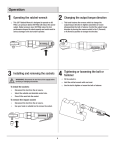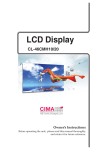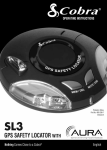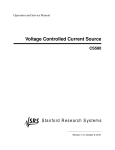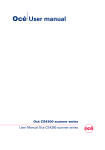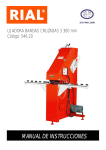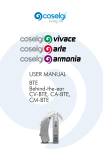Download User's Guide for Tooling
Transcript
Patented Sheet Metal Joining Systems Cross Section of a Lance-N-Loc Joint Cross Section of a Tog-L-Loc Joint Tog-L-Loc & Lance-N-Loc are protected by patents in the U.S.A. and most other industrialized nations. Tog-L-Loc & Lance-N-Loc are registered trademarks of BTM Corporation, Marysville, Michigan U.S.A. Contents Joining Systems Description------------------------------------------------- Page 2 Tog-L-Loc Basics-------------------------------------------------------------- Pages 3-4 Joint Data----------------------------------------------------------------------- Pages 5-6 Joining Theory and Quality Control----------------------------------------- Page 7 Maintaining Joint Quality ---------------------------------------------------- Page 7 Checking Button Dimension With A Tolerance Gauge------------------- Page 8 Maintenance & Adjustment-------------------------------------------------- Page 9 Changing The Die Blades---------------------------------------------------- Pages 10-12 Troubleshooting---------------------------------------------------------------- Pages 13-15 Tooling Record----------------------------------------------------------------- Page 16 ® CORPORATION BTM Corporation 300 Davis Road Marysville, Michigan 48040 U.S.A. Phone 810-364-4567 • Fax 810-364-6178 Revised 042508 User's Guide for Tooling BTM's Tog-L-Loc® and Lance-N-Loc® Joining Systems Description BTM’s Tog-L-Loc and Lance-N-Loc joining systems produce clean, strong and consistent joints in most coated or uncoated metals. The joints are characterized by a “button” formed on the die side layer of metal and a recess formed in the punch side layer. The button is a good indicator of joint quality and therefore, simplifies quality control. Two or more layers of metal typically ranging in thickness from .008” (0.2mm) to .157” (4.0mm) per sheet can be reliably joined in most cases. Tog-L-Loc® Die Side ''Button'' Die Side ''Button'' Cross Section o Cross Section Punch Side Tog-L-Loc is a circular, leakproof joint formed by drawing the metals into a circular “cup” and expanding the diameter to form a 360o lock below the bottom sheet. Clamp Draw Lock Tog-L-Loc is generally preferred due to its omnidirectional strength characteristics, excellent fatigue properties and exceptional tool life. Page 2 Lance-N-Loc® Punch Side Lance-N-Loc is a joint formed by lancing the metals on 2 sides, drawing them through the thickness and expanding the width to form a lock on 2 sides. Clamp Lance Lock Lance-N-Loc is commonly used where metals are insufficiently ductile to join with Tog-L-Loc or in certain dissimilar combinations or multiple layers. Tog-L-Loc Basics A Tog-L-Loc / Lance-N-Loc system consists of 5 major components. 2. The Force Frame: Forces must be contained to prohibit flexing at the punch / die. Deflection will cause degraded joint strength and tool breakage. 1. 2. 4. 3. 5. 3. The Tog-L-Loc / Lance-N-Loc Punch: Tog-L-Loc punches are available in various tip diameters (see joint size page 5), lengths and styles to suit differing application requirements. The perimeter of the round Tog-L-Loc punch tip has a slight radius to prevent piercing. Lance-N-Loc punches are also available in various lengths and styles. The square LanceN-Loc punch tip has cutting edges on two sides and angular ramps on the other two. (Tog-L-Loc Basics continued on following page.) Tog-L-Loc 940 BTM Ball Washer Tog-L-Loc Punches Screw Lance-N-Loc Punches Ball Lock Standard Tog-L-Loc & Lance-N-Loc Metal Joining Systems 1. The Force Mechanism: A device capable of producing sufficient force to form the joint(s). Hydraulic, pneumatic or mechanical presses are generally used. Standard Ball Lock Page 3 4. The Stripper: Both Tog-L-Loc and Lance-N-Loc require use of a spring stripper / clamping mechanism which surrounds the punch tip. The stripper must preload the parts before punch entry, and must allow full punch travel. The spring force must be sufficient to clamp the parts together during joining and prohibit upward extrusion of the metal around the punch. Tog-L-Loc Basics Continued Double Spring Stripper Assembly Preferred Stripper Assembly 940 Stripper Assembly 5. The Tog-L-Loc / Lance-N-Loc Die: Tog-L-Loc dies are available in many styles to suit differing application requirements. The dies have a fixed anvil which is recessed from movable or pivoting blades. A radius is given to the blades' inside edge. Dies are retained by ball lock, set screws or socket head cap screws. The 940 Tog-L-Loc and Lance-N-Loc dies feature a one piece anvil and shield. A spring is used to close the 940 blades. Lance-N-Loc dies are also available in various styles, however, all are two bladed. The blades have cutting edges to the inside, with a fixed anvil recessed from the blade surface. Blade shields are supplied with several die styles. These shields protect the die blades from the force of the stripper and help to retain the blade assembly to the die. In some cases, dies are mounted in pockets within a block which functions as the shield. 940 Lance-N-Loc Die (Preferred Tooling) Tog-L-Loc (Preferred) Die 3 blades and elastomeric ring The spherical retainer is positioned here in this pocket. The retainer and screw hold the die in place. BTM Spherical Retainer Tog-L-Loc (Special Dies) Page 4 940 Tog-L-Loc 3 Bladed Dies (Preferred Tooling) Lance N-Loc (Special Dies) Joint Data BTM sheet metal joining tools are furnished with joint data documentation expressed in the following terms. Punch 940 Style Tog-L-Loc 940 Style Lance-N-Loc Punch Stripper Stripper PTR Joint Size Joint BD Joint Size Joint BD (Button Dimension) (Button Dimension) AD AD (Anvil Depth) (Anvil Depth) Die Die Elastomer Style Tog-L-Loc Punch Punch Stripper Stripper PTR Joint Special Style Lance-N-Loc Joint BD BD (Button Dimension) (Button Dimension) AD AD Die Joint Size Joint Size (Anvil Depth) Die (Anvil Depth) Tog-L-Loc & Lance-N-Loc Metal Joining Systems 1. Joint Size: Expressed as the punch tip diameter (Tog-L-Loc) or width of the die anvil (Lance-N-Loc). For example, a .18" Tog-L-Loc has a punch tip diameter of .180" (4.6mm). Common sizes are: .12" (3.0mm), .18" (4.6mm) and .25" (6.4mm) with special sizes used on occasion. 2. PTR: (Punch Tip Radius): Tog-L-Loc only. Expressed as a decimal figure example: .010'' (0.25mm). This dimension is determined at BTM to suit the application. Joint Data continued Page 5 Joint Data Continued 3. BD (Button Dimension): Diameter or width of the formed joint ''Button.'' BD is expressed as a decimal figure and given a tolerance. Example: .295" + .010" -.000" (7.49mm + .25mm -.000mm). This highly repeatable dimension is used for quality control and is directly linked to joint strength. 4. AD (Anvil Depth): Depth from the top of the die blades to the top of the die anvil. Expressed as a decimal figure Example: .035'' (0.9mm). This dimension is determined at BTM to suit the application. Measuring Button Dimension (BD) 2 Bladed Tog-L-Loc® Die BD=Maximum obtainable measurement in direction of blades opening BD 3 Bladed Tog-L-Loc® Die BD=Minimum obtainable measurement BD 2 Bladed Lance-N-Loc® Die BD=Minimum obtainable measurement in direction of blades opening BD Joint quality (strength) is monitored by measurement of the button dimension (BD). Button dimension is controlled by adjusting punch penetration. Button dimensions specified by BTM are intended to give the optimum combination of joint strength and tool life. BD specification includes a tolerance to accomodate standard mill tolerances in the metals. OTHER PERTINENT INFORMATION INCLUDES THE FOLLOWING: Page 6 1. BTM numbers of punch and die tooling for reference and re-ordering. 2. Metal type and thickness as specified by the customer, as well as orientation - (i.e. punch side/die side.) 3. Location of Tog-L-Loc tooling within machinery where applicable. Joining Theory and Quality Control In order to function reliably, a Tog-L-Loc or Lance-N-Loc system must conform to the following guidelines. The parts to be joined must allow adequate access for the tooling and mate without gaps at the joint locations. 2. The metals to be joined must be sufficiently ductile, within the thickness capabilities of the system and the parts must conform to the tolerances the machine was designed around. 3. The machine must consistently produce sufficient force to form the joints. 4. The machine must contain the force without excessive flexing. 5. The stripper/clamp must apply sufficient force to contain the flow of metal within the die. 6. The tooling must be appropriate to the metals being joined, (i.e. Tog-L-Loc or Lance-N-Loc, joint size, AD and PTR.) Tools purchased for one metal type and thickness may not give the best results with a different metal. 7. The tooling must be adjusted & aligned to properly form the joints, and be secured to maintain these settings. 8. The machine and tooling must be maintained properly so that all components perform their intended function. For example, worn seals can reduce force output thereby affecting joining ability. Maintaining Joint Quality The Lance-N-Loc Punch must have sharp angled edges. (See page 3 of this document.) Lance-N-Loc die blades must be sharp to maintain consistent joint quality. Correct anvil depth in Tog-L-Loc and Lance-N-Loc dies is required to obtain a superior joint. The force unit should be in proper operating condition. A unit in poor condition could influence joint quality. Tooling must be free from dirt, paint chips or sludge that may develop after long use. Inspect tooling at weekly intervals to ensure punches and dies are clean. Punch and die must be in proper alignment to form a good joint. Inspect for weak, compressed or broken stripper springs and replace as necessary. BTM recommends changing springs every 100,000 cycles or when changing tooling. Tog-L-Loc & Lance-N-Loc Metal Joining Systems 1. Page 7 Checking Button Dimension with Tolerance Gauge Joint quality (strength) is monitored by measurement of the button dimension (BD). Button dimension is controlled by adjusting punch penetration. As the shut height is adjusted down the button dimension increases. Backing off the shut height will decrease the button dimension. Button dimensions, as specified by BTM Corporation, are intended to give the optimum combination of joint strength and tool life. Increasing BD to exceed the recommended figure will increase peel strength without measurable effect on shear strength, but will reduce tool life. Reducing BD to less than the recommended figure will prolong tool life at the cost of reduced peel strength; again, shear strength is not greatly affected as long as a lock is achieved. The joint button allows easy visual inspection. Broken, improperly adjusted or misaligned tools produce visually distorted buttons. Defective strippers and part nonconformity will also show up in visual inspection. Refer to “Trouble Shooting” pages 13-15 for specific information. Checking BD with a caliper. Shear Max Peel Go No Go Tolerance Gauge (Go - No Go Gauge) Min The tolerance gauge is a reliable and easy method of monitoring joint quality. These tools are made with a maximum and minimum gauge to allow for button growth resulting from standard mill tolerance within the metals being joined. Monitoring Joint Quality With a Tolerance Gauge Tog-L-Loc MAX. MAX. (GO) (NO GO) (NO GO) MIN. MAX. MAX. (GO) (NO GO) (NO GO) Good Joint Not Acceptable Good Joint Not Acceptable Good Joint Not Acceptable Good Joint Not Acceptable (GO) Page 8 MIN. Lance-N-Loc (GO) MIN. MIN. Maintenance & Adjustment 1. Tog-L-Loc tools are manufactured to be interchangeable so that replacing a punch and or die will not require any shut height adjustment. 3. Machines should be properly maintained, as problems with seals, friction, lubrication, loose or broken parts, cracks in the force frame, etc. can adversely affect the Tog-LLoc Joints. 4. If a problem with the Tog-L-Loc joints arises, use the following checklist before adjusting tools. Tog-L-Loc tools are full hard, (Rockwell C-60 Range) and will not usually require adjustment due to wear. •Check part metals for thickness and hardness. •Check for damage to punch and die. •Check condition of stripper springs. (Replace after 100,000 cycles) •Check operating pressure. •Check machine controls sequence and positive down cycle. •Check adjusting mechanism for loose parts. •Check for flexing, yielding or damage within the force frame. 5. We support our customers and want to know of any problems you may encounter. Should you encounter problems with Tog-L-Loc tooling, call our service department. BTM corporation has extensive experience with Tog-L-Loc in production environments, and will provide expert support. Caution: Observe common safety practices when working with any press tooling equipment. Tog-L-Loc & Lance-N-Loc Metal Joining Systems 2. While periodic adjustment may be necessary, a machine which begins to require frequent shut height adjustments is indicating a problem. Refer to items 3 and 4 below for typical causes. Page 9 Changing the Die Blades 7. THREE BLADE TOG-L-LOC DIE ASSEMBLY: 1. Place the three blades on the anvil, surrounding the top. 2. Slide the elastomeric ring over the top of the blades and into its groove. Blade Anvil Elastomeric Ring Die Body Tog-L-Loc three blade die assembly with elastomeric ring. TWO BLADE TOG-L-LOC DIE ASSEMBLY: 1. Drive the roll pins out of the die body with a punch & hammer. 2. Remove the springs and die blades. 3. Replace with new die blades (and springs if necessary). 4. Replace new roll pins in die body. Anvil Anvil Blade Blade Roll Pin Roll Pin Die Body Spring Body Tog-L-Loc two blade die assembly with internal spring. Page 10 Tog-L-Loc two blade die assembly with external springs. Changing the Die Blades (continued) 940 TOG-L-LOC DIE ASSEMBLY (Canted Coil Spring) Blade Anvil Spring Top View Guard Die Body 940 Die Springs Clockwise Direction 3 blade 940 Style Die 940 LANCE-N-LOC DIE ASSEMBLY Anvil Blade Elastomeric Ring Die Body Lance-N-Loc 2 blade die assembly. 940 TOG-L-LOC DIE ASSEMBLY (Elastomer) To change the die blades in the 940 Elastomer Series dies, special tools (kit numbers listed below) are required to effectively install the elastomer and blade assembly into the die. It will be necessary to also replace the elastomer because it cannot be removed without damaging it. Size Took Kit No. Size Tool Kit No. 3.0-940 711400J 5.5-940 741900N 3.0-940M 710200G 5.5-940M 747700K 3.8-940 793900J 6.4-940 711600N 4.6-940 711500L 6.4-940M 710500X 4.6-940M 710100U 7.6-940 779600P Tog-L-Loc & Lance-N-Loc Metal Joining Systems 1. Remove spring with a small screw driver or tool to pry the spring out. 2. Discard old spring. Springs cannot be reused. 3. Set new blades together in a circle on a flat surface. 4. Place spring over new blades and into groove. Spring should flow around the blades in a clockwise direction. 5. Press spring and blade assembly over diameter of anvil, being careful not to damage or pinch spring. 6. If spring is crimped, bent or breaks during assembly, replace with a new spring. (A damaged spring will produce poor joint quality.) Page 11 Changing the Die Blades (continued) 940 Elastomer Blade Assembly Instructions 1. First, remove the old elastomer by digging it out of the die with a pick or a small screwdriver. 2. Discard old elastomer as it cannot be reused. 3. Replace blades and install a new elastomer as detailed in the procedure outlined below: Place 3 blade sections in assembly base with bottom (larger outside diameter) of blade in counterbore. 1 ASSEMBLY BASE Place elastomer with groove facing down over small end of assembly pin. Push down to beginning of tapered portion of pin. 2 ASSEMBLY PIN 3 Place assembly pin and elastomer on top of blade set with pilot diameter in assembly pin surrounding the blades. Slide elastomer over blades and remove assembly pin. 4 Remove blade sub-assembly from assembly base. 5 Place top of blade sub-assembly into pilot diameter in assembly pin and lubricate elastomer (light oil). 6 Push blade sub-assembly into tapered hole in assembly base until it reaches counterbore (for die assembly). 7 8 9 Page 12 Place counterbore at end of assembly base over top of guard on die assembly. Push assembly pin until the blade assembly snaps past guard and is retained in die assembly. Repeat steps 1-8 as required. Install assembly pin in assembly base as shown for storage when not in use. Tog-L-Loc Trouble Shooting Problems, causes and their corrective actions are given in the order in which they should be checked. Problem Probable Cause l. Total Failure of Joint A. No Button Formed 1. 2. 3. 1. B. Button Partially Formed No "Squeeze" 2. (See also III. Deformed or Distorted Joints) Broken Punch or Die Loss of Operating Pressure Insufficient Force Metals Not of Specified Thickness Die Elastomer or Die Spring Broken 3. Pressure Drop 4. Incorrect Tooling for Metals See also Item E Pg. 9 C. Piercing or cracking of Punch Side Sheet Metal Corrective Action -Replace Tool -Restore Pressure -Check Force -Use Specified Metals or Change to AppropriateTooling -Replace Elastomer or Spring -Restore Pressure -Verify Joint Data / Change Tooling if Necessary 5. Incorrect Shut Height / Tool Adjustment -Adjust Shut Height for Correct BD *Refer to Maintenance Section (pg. 7) 1. Metals Not of Specified Thickness -Use Specified Metals or Change to appropriate Tooling 2. Incorrect Tooling for Metals -Verify Joint Data / Change Tooling if Necessary 3. Weak or Broken Stripper Springs -Replace Spring(s) 4. Punch and Die Not Concentric -Realign Tooling II. Intermittent Failure A. Same Tooling 1. Insufficient Stripper Force to Compensate for Part Variation or NonProduces IntermitMating Parts. tently Good and Bad Parts 2. Parts Do Not Fit Gauging / Nesting 3. Parts Interfere with Tooling Operation -Correct Parts to Conform. Increase Stripper Force -Correct Parts or Gauging to Fit -Correct Parts or Gauging to Allow Clearance Tog-L-Loc & Lance-N-Loc Metal Joining Systems The symbol at left represents a properly formed TOG-L-LOC joint, viewed from the "button" (die) side and in section. BTM TOG-L-LOC tools can commonly produce in excess of 200,000 good joints. Problems can, however, occur. The illustrations below represent possible problem variations of the joint. (Continued) Page 13 Trouble Shooting Problem Corrective Action Probable Cause III. Deformed or Distorted Joints A. Cracks Appear on Button 1. Metals Not of Specified Thickness or Hardness 2. BD Too Large, Tooling Over Adjusted 3. Incorrect Tooling for Metals B. Cracks Appear Inside Joint Cup C. Lump or Irregularity on Button. D. Concentric Double Button E. No Backflow of ButtonRound Top -Use Specified Metals or Change to Appropriate Tooling -Back Off Shut Height Adjustment. -Verify Joint Data / Change Tooling if Necessary 4. Punch and Die Not Concentric -Realign Tooling 5. Excessive Deflection - Check for Damage 1. Metals Not of Specified Thickness or Hardness -Use Specified Metals or Change to appropriateTooling 2. Tooling Incorrect For Metals -Verify Joint Data / Change Tooling if Necessary 3. Punch and die Not Concentric -Realign Tooling 4. Weak or Broken Stripper Spring(s) -Replace Spring(s) 1. Chipped Tool -Replace Tool 1. Missing or Non-Functional Stripper -Replace or Repair Stripper 2. Double Hit -Check Controls / Operator 1. Broken or Weak Stripper Springs -Replace Springs 1. Die Blade Missing or Opened Before Joining -Replace Blade if Missing, or Check for Intererence Causing Blade to Open upon Part Loading. 2. Deflection in Force Frame or Tool Holder -Check for Damage 1. Die Blades Missing -Replace Blades 2. Elastomer or Die Spring Broken (Blades Open) -Replace Elastomer or Spring "Squeezed" See also Item B pg. 8 F. Partial Back Flow of Button G. Dimpling and Unformed Button Page 14 (Continued) Trouble Shooting H. Button Restricted Asymmetrically I. Witnessing (Scarring) J. Button is Out of Round K. Button Restricted Symmetrically Problem Probable Cause Corrective Action 1. Blade is Not Opening -Check for Interference 2. Deflection is Binding Blades -Check for Damage 1. If Heavy: Stripper Spring is Bottoming - Insufficient Spring Travel -Replace With Correct Stripper 2. If Light: Dies are not Protected Adequately -Add Blade Shielding 1. Flexing of Force Frame -Check For Damage 2. Punch and Die are not Concentric -Realign Tooling 1. Metal is Thick for Joint Size or Metal is Soft -Generally not Detrimental to Joint Strength Probable Cause -Check Blade Guarding Corrective Action IV. Distortion of Parts A. Parts are Distorted During Joining 1. Insufficient Stripper Force 2. Stripper Tip too Small -Replace Stripper Springs to Suit -Replace with Large Diameter Tip 3. Die Not Protected -Add Blade Shield 4. Die Blades Below Shield -Adjust Shield Height 5. Misgauging / Nesting -Adjust or Replace Gauging / Nesting to Suit 6. Incorrect Equalization of units on part -Adjust Equalization Stop Tog-L-Loc & Lance-N-Loc Metal Joining Systems Problem Page 15 Tooling Record This Tooling Record form is provided for your convenience. Fill in the form with your data to have this important information readily accessible. Tooling records are provided with your tooling from BTM. Job No. & Location Notes: Pg. 16 Metal Type & Thickness Punch Side Die Side Other Punch No. PTR Die No. AD BD
















